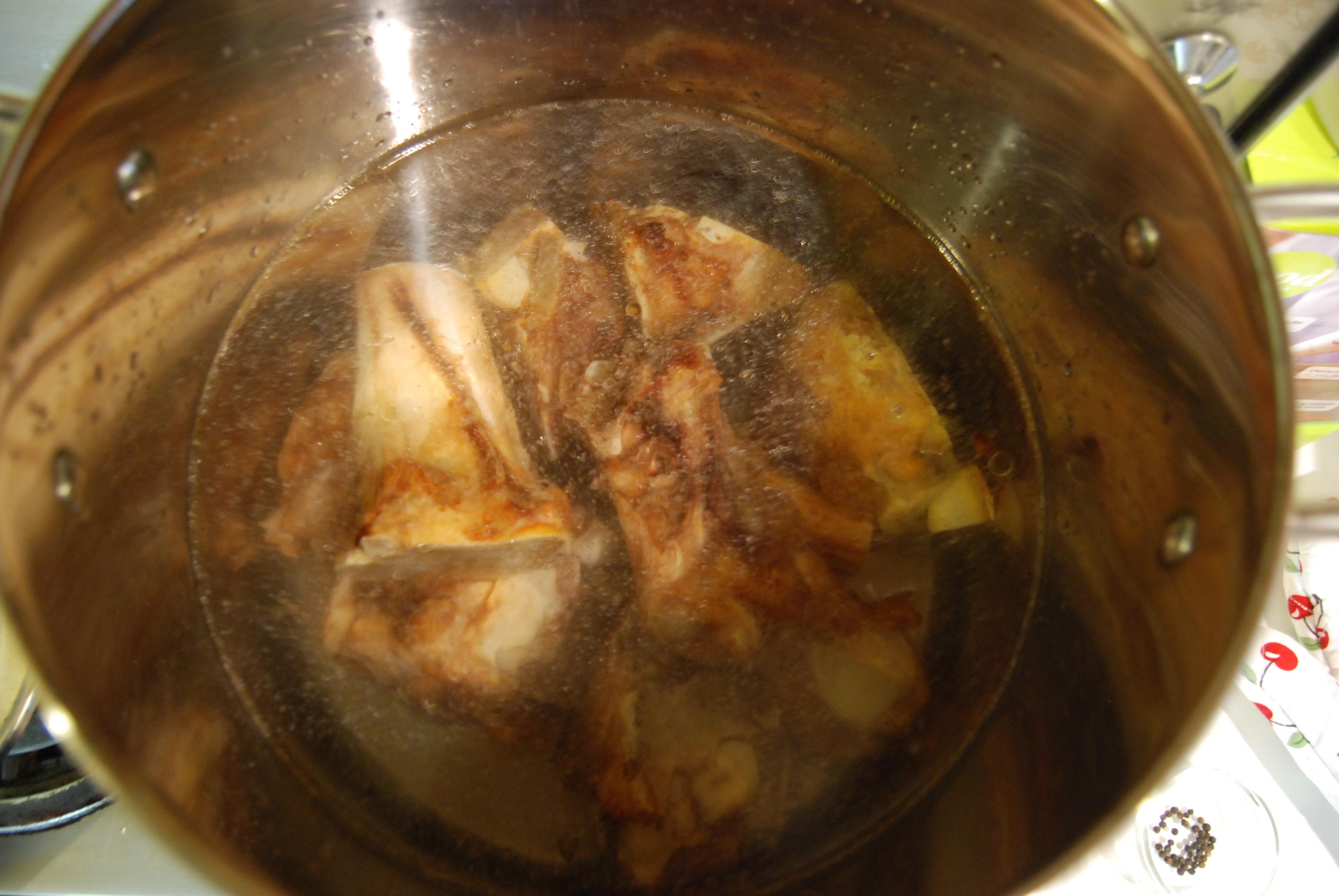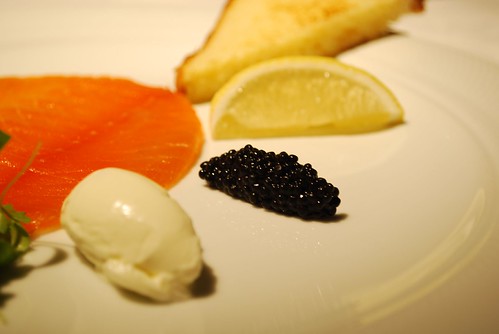There's an old story—perhaps you learned it in grade school—saying that the Native Americans used every part of the buffalo when they killed it. This story is meant to highlight the decadence and wastefulness of Western culture, in contrast to the noble, in-touch-with-nature Natives. Besides its obviously orientalist trappings and its exclusion of non-plains tribes (I don't think the Mi'qmak, Ojibwe, or Potawatomi were hunting buffalo in the woods and northern lakes,) it is also a patently disingenuous statement: Classical Western Cuisine contains hundreds of uses for many parts of pretty much every edible animal.
 |
| Beef bones being used for stock |
From the meat animals, bones are simmered into stock or rendered into glue; hides are tanned for leather, or made into edible items. Many organs are consumed (liver, sweetbreads, kidneys) or used in culinary preparations—some recipes for chili call for ground beef heart, for the flavor it imparts; pigs' feet are used for gelatins and stocks, and chicken feet find great use as a stock component; coxcombs—yes, those things on top of roosters' heads—are served often in classical French cuisine, sometimes in soups and sometimes on their own; jowls and cheeks are used for their fat or braised for their rich flavor.
 |
Caviar with crème fraiche, lemon,
and smoked salmon. By Julia at Avlxyz |
We eat caviar and roe, and old recipes for cod cheeks, tongues, and sounds can be found; fish skeletons are used in stocks and soups; indeed, we often see fish served whole to diners, who will sometimes partake of the non-fillet portions. Squid ink is used to color foods from pasta to forcemeats; squid tentacles are served from deep fried to dried; octopi are eaten with suckers on, (the only portion we discard is the beak—which probably could be used for fish stock.)
There is very little, in truth, that
needs to go to waste in your kitchen. Even with vegetables, many portions we discard out of hand can be saved and used in various manners. Onion skins are valuable for their color, both as a dye component but also as a way to darken a clear soup. Carrot peels and celery ends can go into stock. Onion roots? Stock. Broccoli stems? Soup. The list goes on and on.
The only reason that western culinary culture is so wasteful is because of availability. Why should I carefully cut all the usable red pepper flesh up when I can just go get another one out of the cooler? Why should I use the chicken's feet? There are 2,000 more chickens one phone call away. Why eat this strange organ meat when I can just go over to the supermarket and get another steak?
 |
A Victorian method of
carving a Calf's Head |
This same sentiment is not evident in Victorian cook books, which often include recipes for heads, tongues, tripe, organ meats, and every conceivable part of a given animal—often more than one recipe each, no less. Slowly, from the time of the early cook books in my collection to the modern era, we have come to disregard these portions of an animal as disgusting, inedible, or distasteful to see being cooked—a friend states, "
My father (from China) used to eat chicken feet. When I think about it I still shudder seeing those chicken feet sticking out of the big stockpot." Generations change, tastes change, but not always for good reasons.
We have gotten to the point where we do not
need to use every possible portion of our food, and that's unfortunately led to the death of some culinary traditions. Liver, kidneys, sweetbreads, head cheese, tripe, and so on and so forth are more and more seen as esoteric foods relegated to ethnic cuisines or strange cooking shows—or worse, "Fear Factor" competitions—rather than being accepted as delicious, edible, useful ways to get the most out of your animals.
Consider all the things we throw away in the kitchen, or are thrown away at a butcher's shop. Consider what isn't in the meat case. We do these things not because we
have to, but because we
choose to.
That's all I have for today. I've probably gone on for far too long, but alas—this is something near and dear to my heart. As I've said before, right outside the layer of butterfat.




Besides which, it's just not true. They *could* use every part of the animal, but usually didn't. A favorite method of some tribes was to run an entire herd of buffalo over a cliff to their deaths, and then cut out the tongues and leave the rest.
ReplyDeleteRight up there with using every part of the pig except the squeal! If you're creative and have the time/resources to use it all, go for it. Sometimes it's more trouble than it's worth, unfortunately.
ReplyDeleteThat said, I am trying to learn how to use some of the lesser-known cuts of meat, organs, and anything that might save me some money at the grocery store!
Harriet—
ReplyDeleteSausage—and charcuterie in general—is a great way to utilize trim, and other hard-to-use cuts of meat. In truth, most pâtés and forcemeat preparation (sausages, etc.) evolved from a way to make use of every single bit of meat.
Organs might not be a common feature on this blog, but in time I'll have a variety of ways to use less-expensive or under-utilized cuts of meat.
I come from poor southern farm stock - all was used.
ReplyDeleteBut since I do not raise the animals that I eat nowadays myself, I avoid any organs that function as filters, or would concentrate the things that factory farmed meat is fed.
Liver and kidneys filter toxins and process many drugs. As a nurse, I know way too much about what is likely lurking in organ meats from my local grocery megamart.
If you crave organ meats I would strongly suggest going with organic certified meat.
Unlike my predecessors I would not eat brains under any circumstances as prionic brain diseases can jump species and are much more common since the practice of feeding dead animals to their own species has become more commonplace. Think "mad cow".
I am fortunate enough to live somewhere that hunting is legal, so can sometimes get wild meat - which tastes SO much better :)
Organ meats are definitely a little unsettling, it's true. I've had Foie Gras, which is just divine, but so far have managed to avoid knowingly eating any other livers (both through choice and through chance,) kidneys, etcetera. I did have some bone marrow the other week, that was pretty tasty.
ReplyDeleteBut what about Armour Pork Brains In Gravy, which give you some 2000% of your RDA of cholesterol?
Venison and wild boar are the two game meats that I've had that were actually wild-shot (I've had farmed Pheasant, Quail, and Rabbit,) and they were both remarkably delicious. The Wild Boar was especially exciting to have, since it was prepared in a very gourmet style....
Aw hell, now I'm hungry and it's only 10:30 AM...
I'm willing to try anything once.
ReplyDelete